The size of a cow is essential when thinking of what type of cattle to keep on your farm. While most farmers prefer large cows, they also come with their challenges.
Larger breeds require more space than smaller cow breeds, and certain breeds can find it difficult to adapt to the specific climate and environmental conditions on a farm.
Nonetheless, big cow breeds can also guarantee profitability if you raise them for milk and beef.
Our detailed guide covers some of the largest breeds of cows and their characteristics.
Table of Contents
12 Largest Cow Breeds
Some of the largest breeds of cows are:
1. Chianina
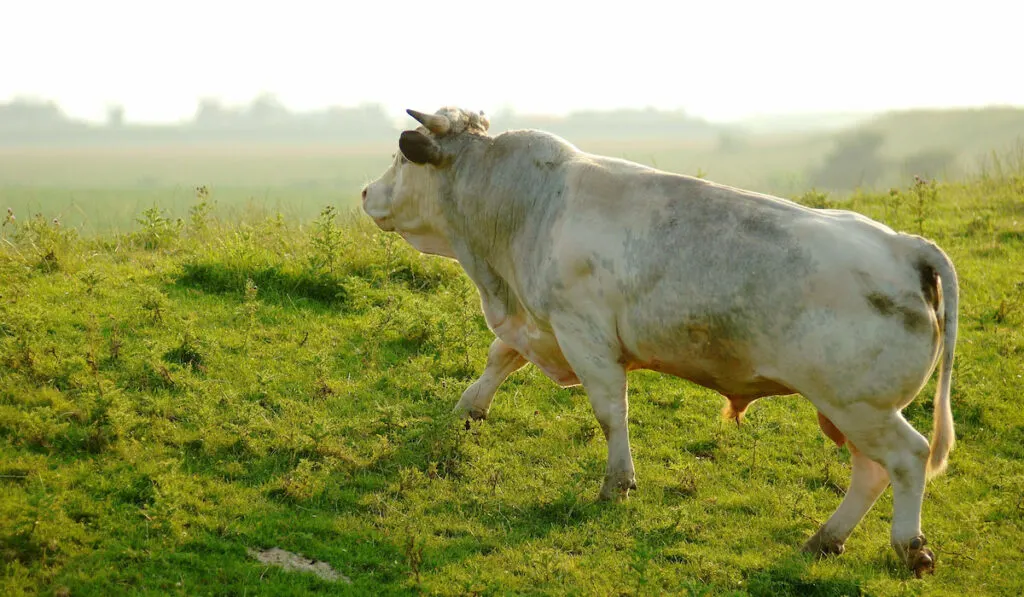
The Chianina is one of the oldest cattle breeds from the Italian region of Tuscany. It was used as a draught animal, but modern farming has emphasized the breed’s ability to produce beef.
It’s one of the largest and heaviest breeds of cattle. A mature bull is about 5 ft. 11 in. tall, while castrated oxen may reach up to 6 ft. 7 in.
Bulls can also weigh up to 3,527 lbs (1600 kg). A male that is over four feet is termed as top-grade.
Cows can weigh up to 1,984 lbs (900 kg), but some may exceed 2,204 lbs (1000 kg), with some standing over five feet tall. These are considered top-grade.
Chianina have white hair and black skin pigmentation. Bulls are dark gray near the front. Their short horns curve forward and are black in young animals and lighter in mature animals.
Chianina also have longer legs than most breeds.
They are gentle and heat tolerant. Chianina are now selected for beef, thanks to their consistent and high growth rates.
2. Parthenais
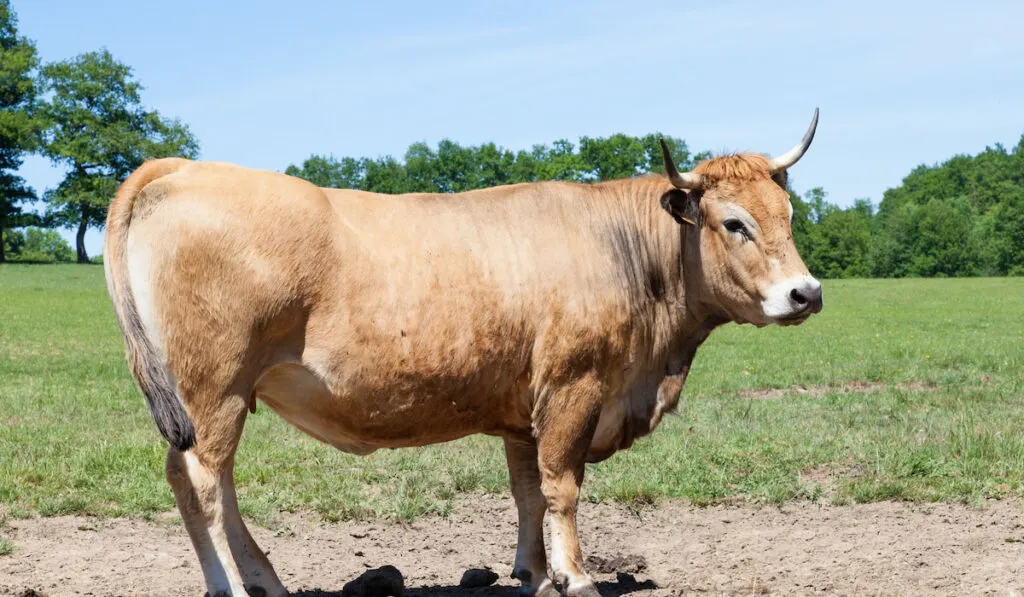
Parthenais are originally from France around the borders of Brittany. It’s one of the oldest French breeds kept for draught work and quality milk.
Established in 1893, this breed was also raised for its quality beef.
The Parthenais breed has a dark brown coat color and a black neck, ears, eyes, and jaw. Its hooves, nose, and tail are also black.
A mature cow can weigh up to 1,984 lbs (900 kg), while bulls can weigh up to 2,645 lbs (1200 kg). These cattle are famous for their lean, high-quality meat.
Parthenais are also hardy, fertile, and can adapt to all climate conditions.
3. Glan Cattle
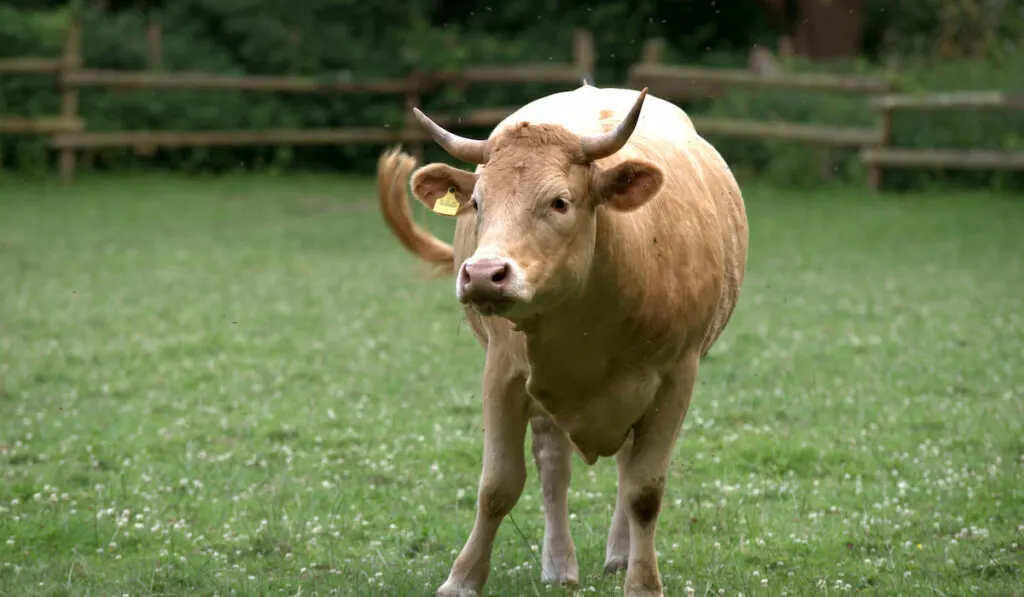
Glan cattle are another large dual-purpose breed. They can also be used as draught animals. This cattle breed originally from Germany dates to the 18th century.
These cattle have yellow coats, and both the bulls and cows have horns.
A mature bull can weigh up to 2,204 lbs (1000 kg), while a cow weighs around 1,322-1,543 lbs (600-700 kg). Glan bulls have a height of up to 57 in. (145 cm) and cows average 55 in. (140 cm).
These cattle are kept in systems for their milk production. A cow can create about 1,056 gal (4,000 L) of milk for every lactation. Glan cattle milk has about 4% butterfat and 3.53% protein.
The breed can survive in native climates, are active, and are suitable for meat. On the downside, Glan cattle grow relatively slower than other large breeds.
4. South Devon
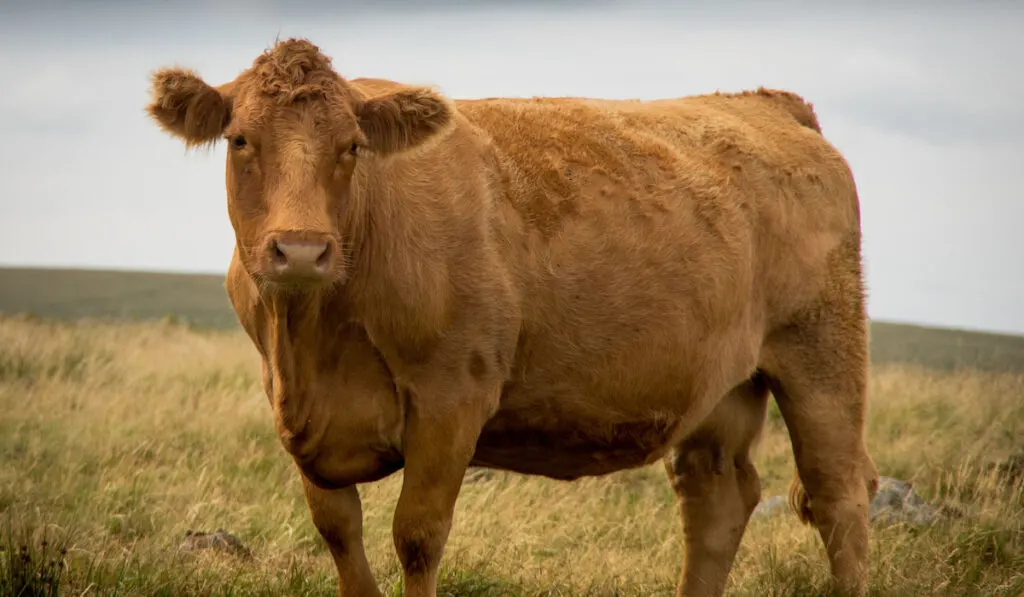
South Devon cattle are a dual-purpose breed from Cornwall and Devon in Southwest England.
It’s one of the largest British cattle breeds that are thought to have been imported during the Norman invasion of England.
Although it was considered a dual-purpose breed in the 1800s, it’s now mainly kept for its quality, flavorful beef.
Apart from being large, they have thick skin and medium-red copper tints to their fur, and some appear slightly mottled. There are also polled and horned breeds.
They are a popular beef breed because bulls mature earlier and grow faster. Cows also mature early and can be calved at two years of age and are also known for their maternal characteristics.
On average, a bull weighs between 2,645-3,527 lbs (1200-1600 kg), while a cow weighs about 1,543 lbs (700 kg).
South Devon cattle are a favorite for their performance, hardiness, and adaptability to different climates.
5. German Angus
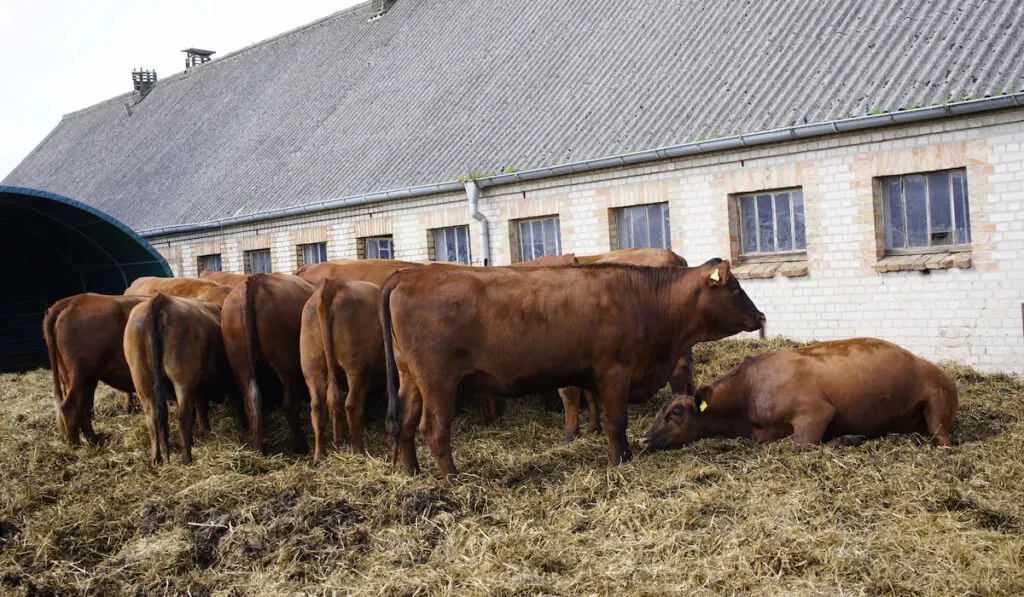
German Angus is a breed created by crossing the Aberdeen Angus cattle with various German breeds like Gelbvieh and Fleckvieh. This makes it heavier and bigger compared to the original breeds.
The crossbreeding aimed to create a breed with high milk yield, quality meat with low-fat content, and a good temperament.
This medium to large breed is naturally polled and can have a yellow-grey, dark brown, or black color with white patches.
A German Angus bull weighs about 2,645 lbs (1200kg) with a height of up to 59 in. (150cm). Cows weigh about 15,432 lbs (7000kg) with a height of 55 in. (140cm).
Although the Angus is primarily a beef breed, German Angus is also great for milk production. Cows have good calving abilities and milk production.
They also mature early and adapt well to native climates.
6. Maine-Anjou
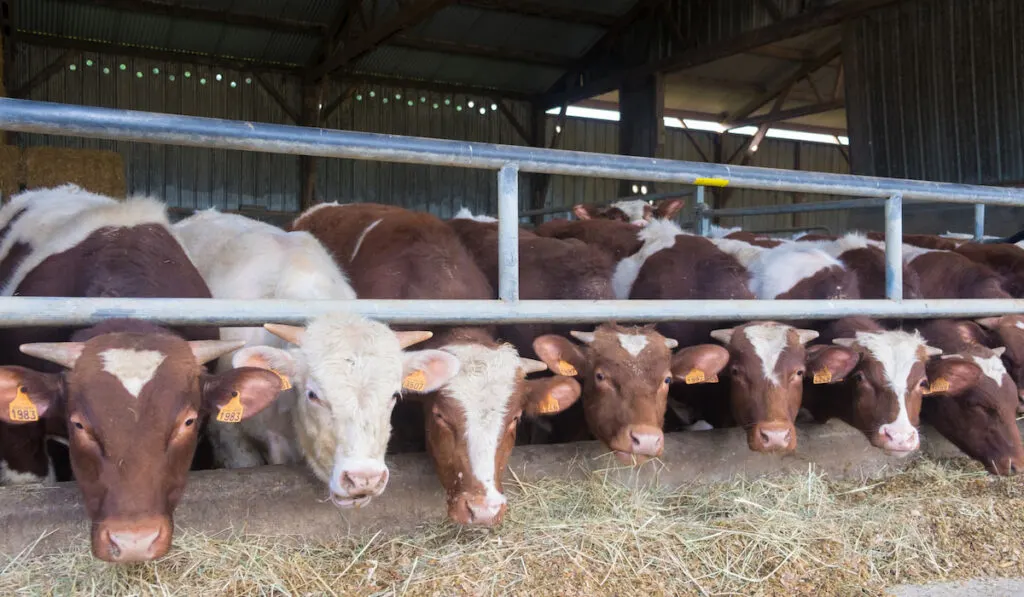
The Maine-Anjou breed is originally from West France, the Anjou region. Apart from being raised as a dual-purpose breed, Maine Anjou was also used as a draught animal.
Now mainly kept for beef production, these cattle were imported into the U.S. through artificial insemination.
Maine-Anjou has a red and white color, but some may be roan or black. They also have white patches on their legs, underside, tail, and head.
The breed can also be polled or have horns that curve forward.
Being the largest of the French breeds, Maine-Anjou bulls can weigh up to 3,086 lbs (1400kg), while the cows, on average, weigh about 1,873 lbs (850 kg).
Most farmers love this breed as it excels in performance-feed efficiency, calves easily with good mothering abilities, and their docile nature.
They mature and gain weight quickly. Their beef is well-marbled with minimal fat cover and a substantial rib-eye area.
7. Montbeliarde
The Montbeliarde cattle breed is a large breed with its origins in France. This breed was named the Alsatian breed originally, which was later changed to Montbeliarde in the 1800s.
These cattle are famous for their quality milk production, which is later processed into cheese.
It is red and white, with a light muzzle and ultra-shaped horns. A Montbeliarde bull weighs about 2,645 lbs (1200kg) and stands 58 in. (148cm), while a cow weighs about 1,543 lbs (700 kg) with a height of 55 in. (140cm).
The breed is easy to manage and adapts well to all environments.
Farmers looking for calving ease, high protein content milk, longevity, and a breed with a high success rate in artificial insemination will find the Montbeliarde ticks all these boxes.
Montbeliarde cows produce about 1,849 gal (7,000 L) of milk per lactation; the milk has 3% butterfat content and 3.4% protein, making it perfect for cheesemaking.
While the breed is mainly raised for its milk, it also produces quality meat without excess fat.
8. Bazadaise
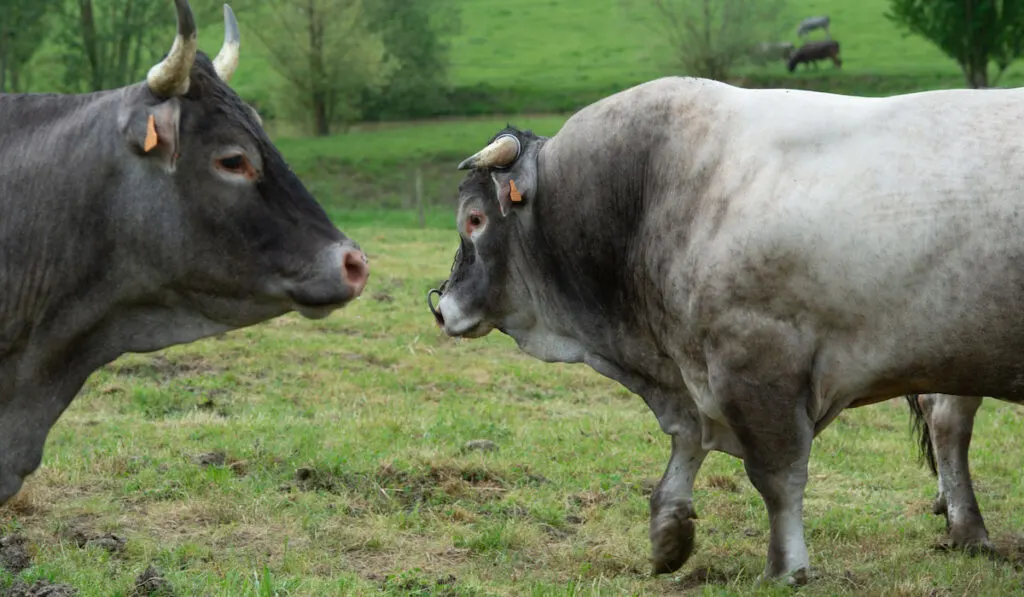
The Bazadaise cattle originated from South of the River Garonne in France. Being a domestic beef cattle, the breed is believed to originate from interbreeding local cattle breeds of Spanish origin.
Bazadaise cattle have black skin with a pale muzzle. The medium to large animals have horns with black tips and a yellow base.
Mature bulls weigh 2,204 lbs (1000 kg) with a height of 57 in. (145 cm), while cows weigh about 1,543 lbs (700kg) with a height of 55 in. (140 cm).
The Bazadaise cattle are raised for meat production. You’ll find their meat fine flavored and less fatty compared to most beef breeds.
Their rapid growth means that a calf at four months weighs 440 lbs (200 kg) and can achieve a weight of 1,102 lbs (500 kg) in 14 months.
Research shows that Bazadaise cattle have about 70% of all calving intervals that are less than 380 days. That makes them excellent breeders.
9. Charolais
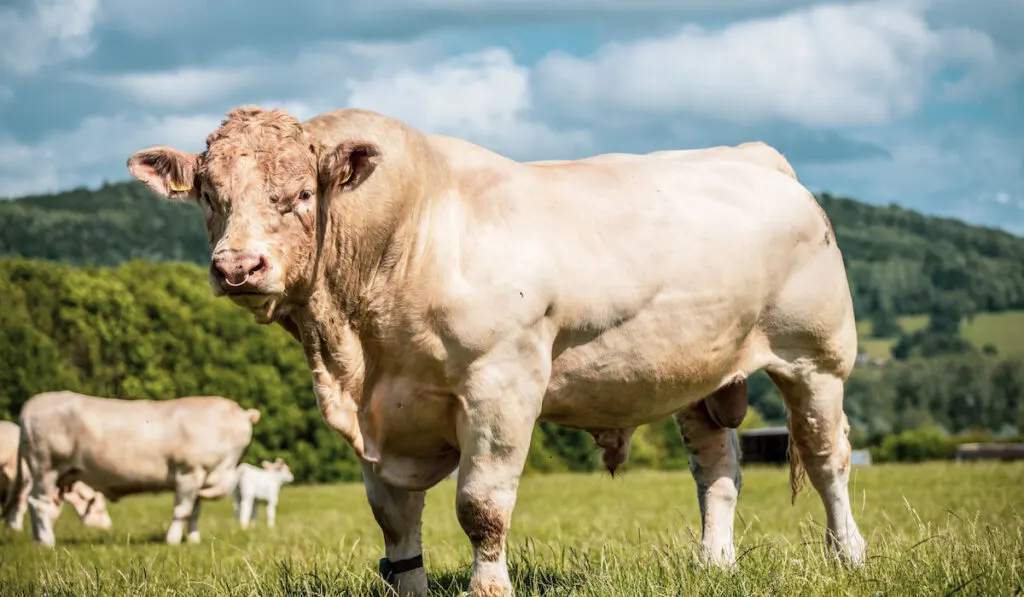
The Charolais cattle breed is famous for its massive size and white-creamish coloring.
Charolais was developed in the Charolais district in the 17th century as one of the oldest French breeds. The breed was later introduced to the US in 1934.
Charolais are large-framed animals that are heavily muscled. They have a white color and a pink muzzle, but it’s not uncommon to see these cattle in black and red colors.
Most of these cattle are horned, although some polled ones are being developed.
A mature bull weighs up to 3,527 lbs (1600 kg) with a height of 60 in. (153 cm), while a cow weighs up to 2,645 lbs (1200 kg) with a height of 59 in.(150 cm).
Despite its late maturity, the breed is also raised for its quality beef. They are also easier to manage in terms of temperament and calving.
Charolais also fits in any climate and environment, whether you’re practicing intensive or grass-based farming.
Apart from beef. Charolais can also be kept for dairy and draught uses. Muscular bulls can haul heavy loads and help around the farm.
10. Brahman
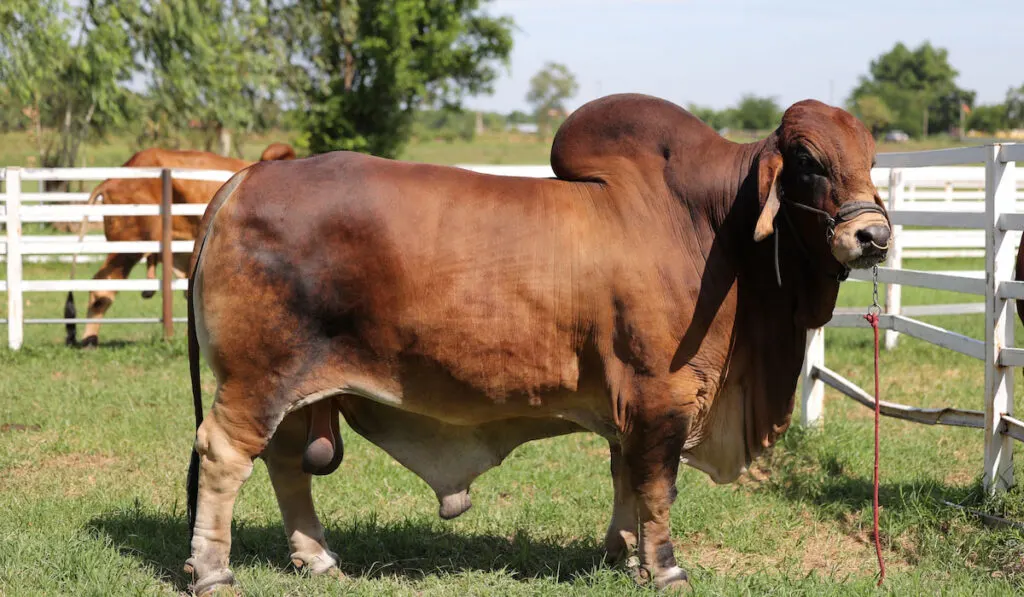
Brahman is another large breed raised for milk, meat, and draught uses.
The Indian breed was introduced in the US in 1885. Due to their origin, these cattle can survive in high humidity and heat.
The medium to large-sized animals have long heads and a high hunchback. Their ears also droop and are long, Brahman cattle are red and grey, but it’s common to find some white, black, and brown animals.
A mature bull weighs about 2,425 lbs (1100 kg), while a mature cow is about 1,543 lbs (700 kg).
These cattle mature late, which means the carcass of the young ones is lean.
A Brahman also makes an excellent crossbreeder. It’s been used to develop different crossbreeds like Charbray and Droughtmaster.
Besides being adaptable to different climates and feeding, Brahmans are also docile and like to be treated gently. That makes them easier to handle.
The cows make good mothers and produce enough milk under ideal conditions.
11. Pinzgauer Cattle
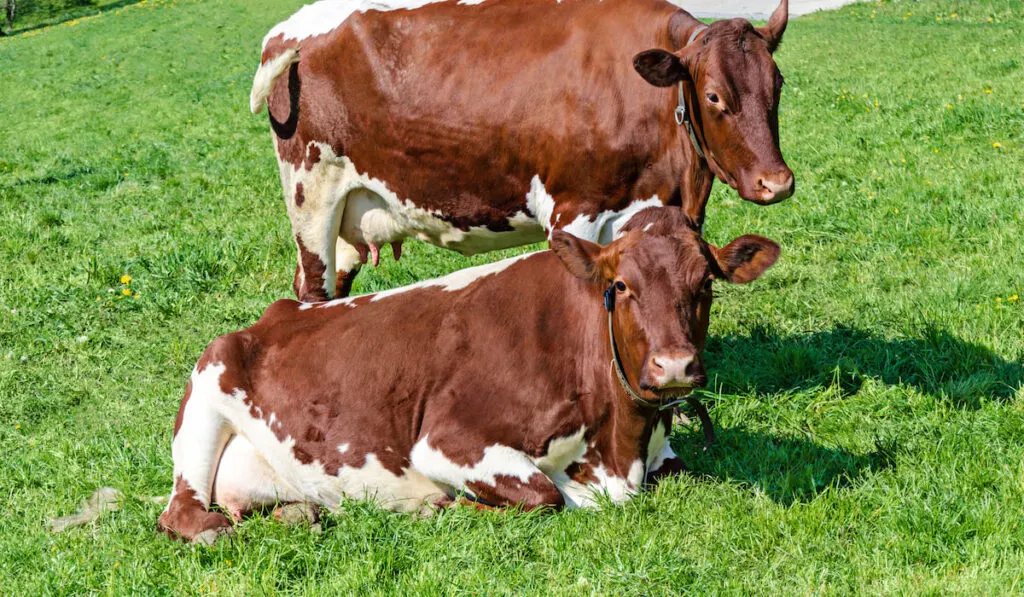
Pinzgauer cattle originated in Austria and share some genetic characteristics with North German lowland breeds.
Although it was mainly raised as a draught animal, the breed became famous for its meat and milk in 1896.
The medium to large-sized breed has an auburn color, but some are also black. Their abdomen, tail, udder, and chest are white. Pinzgauer cattle can also be polled or horned.
A mature bull weighs about 2,425 lbs (1100 kg) and stands at 57 in. (147 cm), while a mature cow weighs about 1,543 lbs (700 kg) with a height of 53 in. (137 cm).
The breed is hardy and easily adapts to different climates. Pinzgauer cattle are also calm and are praised for their disease resistance and feed efficiency.
Being a dual-purpose breed, these cattle have quality beef with a fine flavor and excellent marbling.
Their milk is also high quality, with 3.8% fat and 3.2% protein. Cows can produce up to 1,320 gal (5000 L) of milk for every lactation.
12. Belted Galloway
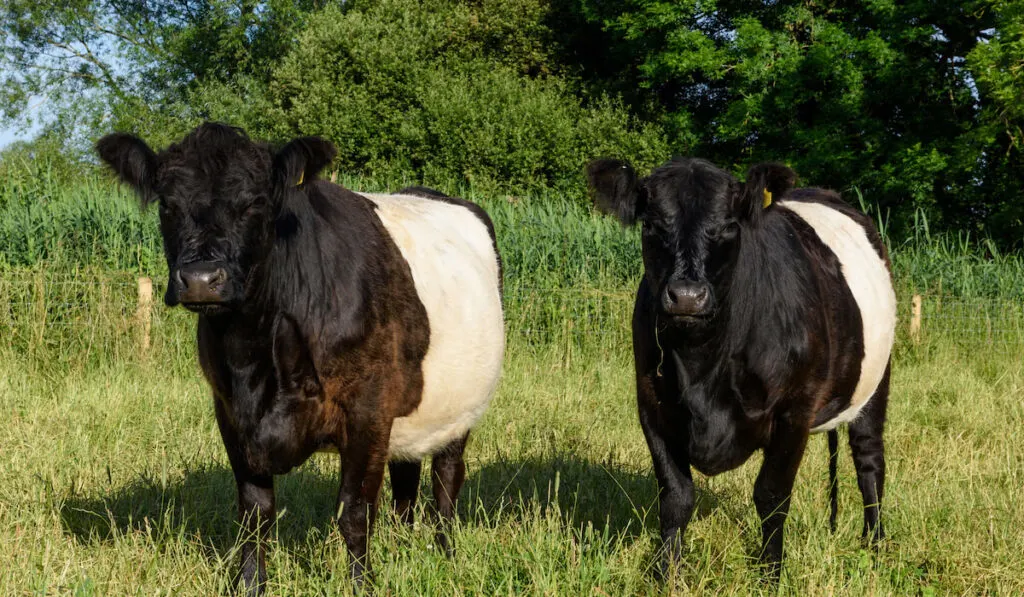
The Belted Galloway is one of the easy-to-recognize breeds due to its unique appearance. It’s mainly raised for its meat.
Originally from Southwest Scotland, the breed was later introduced in the US. That allows it to adapt quickly to any climate.
The breed is predominantly black, with a white-like section encircling the body. It can also have a red or dun body depending on its origin.
The Belted Galloway is naturally polled, so you won’t have to deal with horns. They can be crossed with another breed to prevent the growth of horns.
These cattle can adapt to various climatic conditions and are excellent foragers.
A mature bull weighs about 2,204 lbs (1000 kg), while a cow weighs about 1,433 lbs (650 kg).
Most farmers rear the Belted Galloway for its uniquely flavored beef with a soft texture. Its meat has a fat content of about 2%, which is extremely low.
These cattle also produce a lot of rich milk. It also has a soft undercoat for warmth and a double coat of long hair that sheds off the rain.
Their ability to survive in any condition makes them resistant to diseases like pink eye and foot problems.
Final Thoughts
Those are some of the largest cattle breeds you’re likely to come across on most farms. These cattle are hardy and can adapt to various weather conditions and environments.
Most of them are dual-purpose breeds that can be raised for beef and milk production. The only downside is that these cattle need a lot of water and food and plenty of space to roam.
Resources
- http://www.cattlenetwork.net/Breeds/chianina.htm
- http://afs.okstate.edu/breeds/cattle/chianina/index.html/
- https://www.parthenais.co.uk/home/about/
- https://maine-anjou.ca/index.html
- http://afs.okstate.edu/breeds/cattle/glan/index.html/
- http://afs.okstate.edu/breeds/cattle/glan/index.html/
- http://www.sdhbs.org.uk/index.php/breed/breed-characteristics
- https://www.montbeliarde.org/assets/files/Publications/fiches-techniques/Version_anglaise.pdf
- https://www.thecattlesite.com/breeds/beef/11/charolais/
- https://www.thecattlesite.com/breeds/beef/63/pinzgauer/
